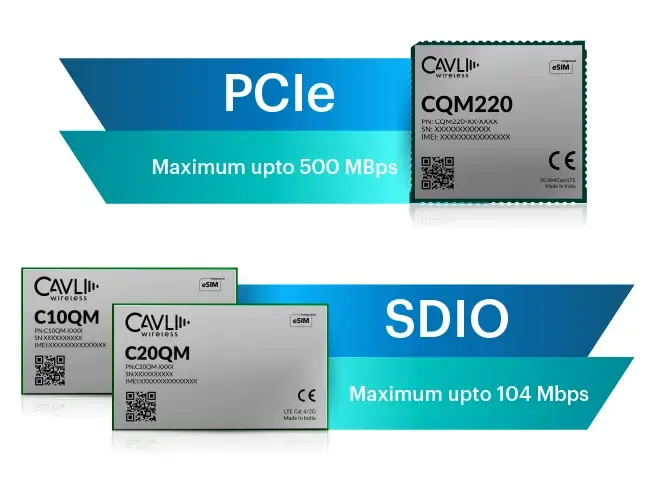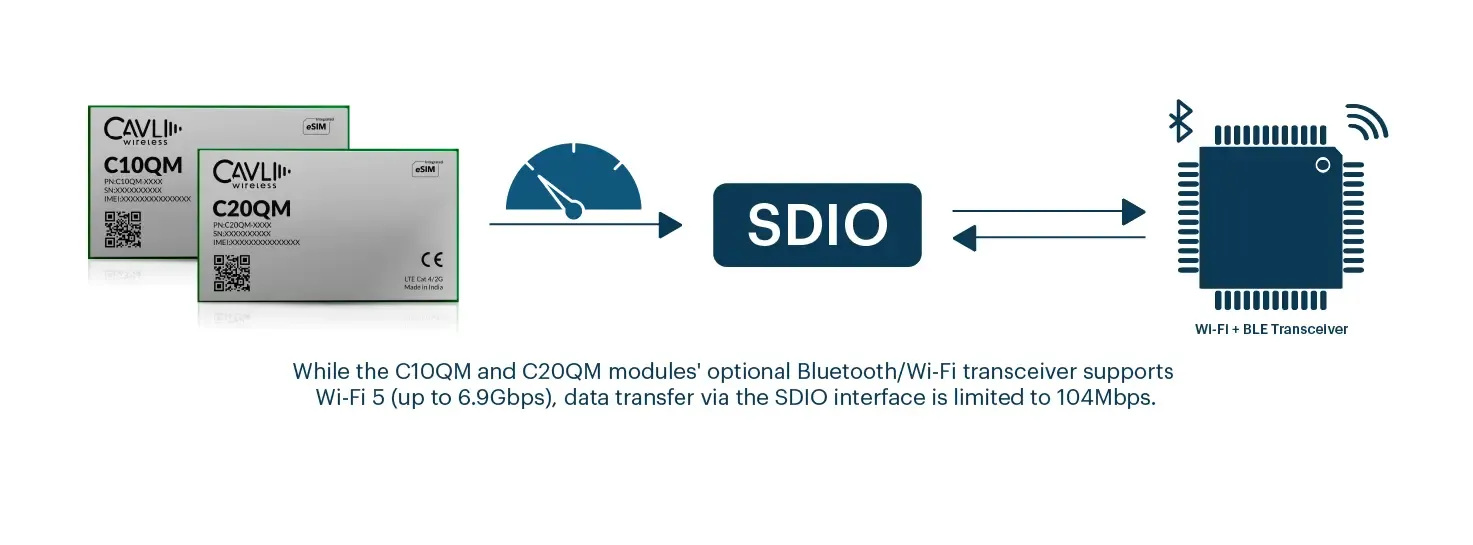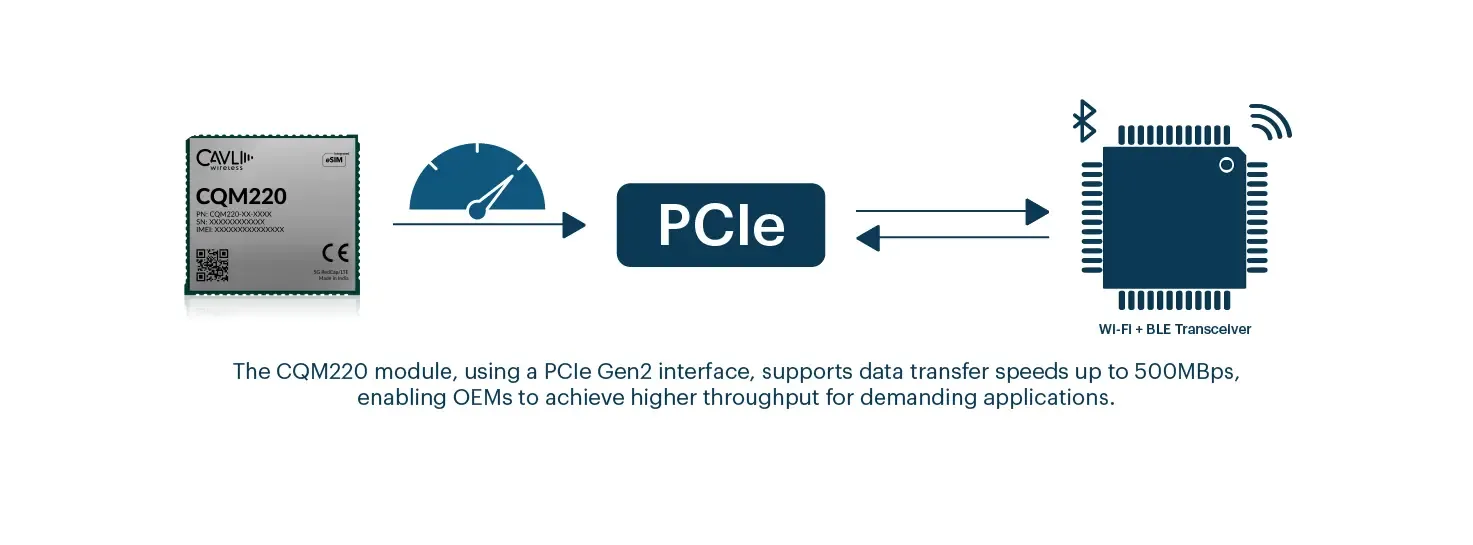In the ever-evolving landscape of IoT, connectivity is king. The ability to transmit and receive data quickly and reliably is paramount for a wide range of applications. However, achieving optimal throughput often comes at a premium, forcing OEMs to balance performance requirements with budget constraints. While high-bandwidth solutions are essential for certain applications, many IoT use cases can thrive with more cost-effective, moderate-bandwidth options.
Cavli understands this delicate balancing act and offers a range of cellular modules designed to address the diverse needs of the IoT ecosystem. This blog post explores the bandwidth considerations surrounding Cavli's C10QM, C20QM, and CQM220 modules, highlighting how OEMs can choose the right connectivity solution for their specific applications.
The challenge for OEMs developing connected solutions often revolves around selecting the appropriate level of connectivity. High-bandwidth applications, like streaming high-definition video, demand cutting-edge technology and often come with a higher price tag. However, many IoT applications, such as industrial monitoring or asset tracking, don't require such extreme throughput. Choosing a module with more moderate bandwidth capabilities can significantly reduce costs without sacrificing essential functionality.
Say hello to the Contenders: Cavli C10QM and CQM220
Cavli's C10QM, C20QM, and CQM220 modules offer a spectrum of connectivity options, each tailored to specific application requirements. The C10QM and C20QM are based on the Qualcomm MDM9207 chipset, supporting LTE Cat 1/2G and Cat 4/2G respectively. They feature an Arm Cortex A7 processor and run Yocto Linux 4.14, providing a flexible platform for custom IoT applications. These modules integrate Wi-Fi 5 and Bluetooth 5.0 connectivity via an external transceiver connected through the SDIO interface.
The CQM220, based on SDX35 chipset, offers 5G RedCap along with LTE Cat 4 fallback and utilizes a PCIe Gen2 1-lane interface for its Wi-Fi/Bluetooth connectivity. This architectural difference plays a crucial role in determining the maximum achievable throughput.
SDIO emerged as an extension of the Secure Digital (SD) card standard, leveraging the existing infrastructure and form factor for connecting peripherals beyond just memory cards. Initially introduced in the early 2000s, SDIO gained popularity in embedded systems and mobile devices due to its low cost, small size, and ease of integration. This allowed manufacturers to add functionalities like Wi-Fi and Bluetooth to their devices without requiring separate, dedicated interfaces. However, SDIO's relatively low bandwidth compared to other interconnect standards like USB or PCIe limited its suitability for high-throughput applications.
PCIe, on the other hand, was developed as a high-performance successor to the older PCI and PCI-X bus standards. First introduced in the mid-2000s, PCIe offered a significant improvement in bandwidth and latency, utilizing a serial point-to-point architecture for faster and more efficient data transfer. It quickly gained widespread adoption in desktop computers, servers, and high-performance embedded systems. PCIe's scalable architecture, with various lane configurations supporting different bandwidth requirements, has enabled its use in a wide range of applications, from high-speed graphics cards and networking adapters to storage devices and industrial control systems. Its high bandwidth and low latency have made PCIe the preferred interconnect standard for demanding applications requiring fast and reliable data transfer.
Navigating Bandwidth Limitations and Opportunities
While the Wi-Fi 5/BT 5.0 transceiver used in the C10QM and C20QM theoretically supports speeds up to 433Mbps, the SDIO interface creates a bottleneck, limiting the practical throughput to 104Mbps. This limitation is a crucial consideration for OEMs. In contrast, the CQM220's PCIe interface supports speeds up to 500Mbps, effectively removing the bottleneck and enabling significantly higher throughput.

SDIO (Secure Digital Input/Output): An interface primarily designed for connecting peripherals to embedded systems, often utilizing the same physical form factor and pinout as SD memory cards. It allows for relatively low-cost integration of various peripherals, including Wi-Fi, Bluetooth, GPS, and cameras. Max bandwidth on offer is upto 104Mbps.
PCIe (Peripheral Component Interconnect Express): A high-speed serial expansion bus standard designed for connecting peripherals to computer systems. It offers significantly higher bandwidth and lower latency compared to SDIO, enabling faster data transfer and improved performance. Max bandwidth on offer is upto 500MBps in single lane (Gen2).
The SDIO interface, while offering a cost-effective and widely implemented solution for integrating peripherals like Wi-Fi and Bluetooth, inherently has lower throughput capabilities compared to interfaces like PCIe. This is due to factors like bus speed, data transfer protocols, and overhead associated with the SDIO standard. The SDIO interface on the C10QM and C20QM operates at a speed that, while sufficient for many IoT applications, cannot fully utilize the maximum potential of the Wi-Fi 5 transceiver. The result is a bandwidth bottleneck where the module's overall throughput is limited by the SDIO interface speed rather than the transceiver's capabilities.
Now, let's contrast this with the CQM220, which overcomes the SDIO bottleneck by utilizing a PCIe Gen2 1-lane interface for its Wi-Fi/Bluetooth connectivity. PCIe, known for its high-speed data transfer capabilities, allows the CQM220 to achieve throughput of up to 500Mbps. This significantly higher bandwidth opens up new possibilities for demanding applications, such as high-definition video streaming, real-time data analytics, and edge computing. For OEMs developing these bandwidth-intensive applications, the CQM220 offers a compelling solution.
Engineering Implications for OEMs
Imagine an OEM developing a smart security system with high-definition video streaming capabilities. In this scenario, the CQM220, with its high-throughput PCIe interface, is the clear choice. The unconstrained bandwidth ensures smooth and reliable video streaming, crucial for real-time monitoring and security applications. However, for an OEM developing an industrial gateway, where the primary function is to collect and transmit sensor data from factory machinery, the C10QM or C20QM might be the more practical option. While the bandwidth is limited to 104Mbps, it's more than sufficient for transmitting sensor data, which typically doesn’t require high throughput. This choice allows the OEM to leverage the cost-effectiveness of the C10QM/C20QM without compromising essential functionality.

Consider another analogy: choosing between a high-speed sports car and a fuel-efficient sedan. The sports car offers exhilarating performance but comes at a premium, while the sedan provides reliable transportation at a more affordable price. Similarly, the CQM220 offers high-bandwidth performance for demanding applications, while the C10QM/C20QM provide a cost-effective solution for applications with moderate bandwidth requirements.
Choice of Seamless Connectivity vs. Cost Optimization for End Users
Imagine a farmer utilizing a smart irrigation system managed by a network of sensors and a central gateway powered by a C10QM. The sensors collect data on soil moisture, temperature, and other environmental factors, transmitting this information wirelessly to the gateway. The gateway, in turn, communicates with a central server to automate irrigation schedules and optimize water usage. In this scenario, the bandwidth limitations of the C10QM's SDIO interface are not a significant impediment. The data packets transmitted by the sensors are relatively small, and the required data rates are well within the capabilities of the 104Mbps throughput provided by the SDIO interface. The farmer benefits from the cost-effectiveness of the C10QM without experiencing any performance bottlenecks. They achieve efficient and reliable irrigation management, conserving water and maximizing crop yields, all while minimizing their investment in connectivity hardware.

Now, consider a user relying on a home security system powered by a CQM220. They expect crystal-clear, real-time video streaming to their mobile device, even when remotely accessing multiple cameras simultaneously. The CQM220's high throughput, enabled by the PCIe interface, ensures a smooth and uninterrupted viewing experience, providing peace of mind and enhanced security. This seamless connectivity allows them to monitor their property effectively, receive instant alerts, and quickly respond to any potential security breaches. In this scenario, the premium paid for the high-bandwidth CQM220 translates directly to a tangible benefit for the end-user: enhanced security and peace of mind. They are willing to invest in the higher-performing module to ensure the reliability and responsiveness of their security system.
Closing Notes:
The key takeaway is that there's no one-size-fits-all solution in IoT connectivity. Cavli's diverse range of modules, including the C10QM, C20QM, and CQM220, provides OEMs with the flexibility to choose the right tool for the job. By understanding the bandwidth requirements of their specific applications and balancing performance needs with budget considerations, OEMs can create optimized connected solutions that deliver maximum value to their end users.
Go Beyond and Explore
What are the key differences between the SDIO and PCIe interfaces in Cavli’s modules, and how do they impact performance?
Highlights the technical contrast between SDIO (used in C10QM and C20QM) and PCIe (used in CQM220) and their effect on bandwidth and application suitability.
Which applications are best suited for the CQM220 module, and how does its PCIe interface enhance performance?
Focuses on high-bandwidth use cases like real-time video streaming and how the PCIe interface enables seamless operation in demanding environments.
How do the L1-only and L1+L5 GNSS variants differ?
The C17QS module powers various IoT applications, including:
- Asset Tracking: High-value asset monitoring with enhanced accuracy and security.
- Smart Toll Collection Solutions: Enables future proof toll collection that bills based on distance travelled on a particular toll road.
- Precision Farming: Guiding autonomous tractors and other agricultural machinery, optimizing irrigation and fertilizer application based on location.
What factors should OEMs consider when selecting between the C10QM, C20QM, and CQM220 modules?
Discusses the balance between cost-effectiveness and performance based on application-specific bandwidth requirements.
How does the choice of connectivity module affect the end-user experience in IoT applications like security systems or smart agriculture?
Examines how bandwidth capabilities translate into real-world benefits for end users, such as efficient irrigation or high-quality video streaming.


